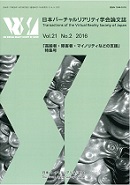Volume 26, Issue 3
Displaying 1-7 of 7 articles from this issue
- |<
- <
- 1
- >
- >|
-
2021 Volume 26 Issue 3 Pages 159
Published: September 30, 2021
Released on J-STAGE: September 30, 2021
Download PDF (910K)
-
2021 Volume 26 Issue 3 Pages 160-168
Published: September 30, 2021
Released on J-STAGE: September 30, 2021
Download PDF (3240K)
-
2021 Volume 26 Issue 3 Pages 169-176
Published: September 30, 2021
Released on J-STAGE: September 30, 2021
Download PDF (1482K)
-
2021 Volume 26 Issue 3 Pages 177-186
Published: September 30, 2021
Released on J-STAGE: September 30, 2021
Download PDF (1968K)
-
2021 Volume 26 Issue 3 Pages 187-197
Published: September 30, 2021
Released on J-STAGE: September 30, 2021
Download PDF (30839K)
-
2021 Volume 26 Issue 3 Pages 198-207
Published: September 30, 2021
Released on J-STAGE: September 30, 2021
Download PDF (13319K)
-
Modulation of walking speed by the change in motion and shape of the virtual avatar moving alongside2021 Volume 26 Issue 3 Pages 208-218
Published: September 30, 2021
Released on J-STAGE: September 30, 2021
Download PDF (3645K)
- |<
- <
- 1
- >
- >|
